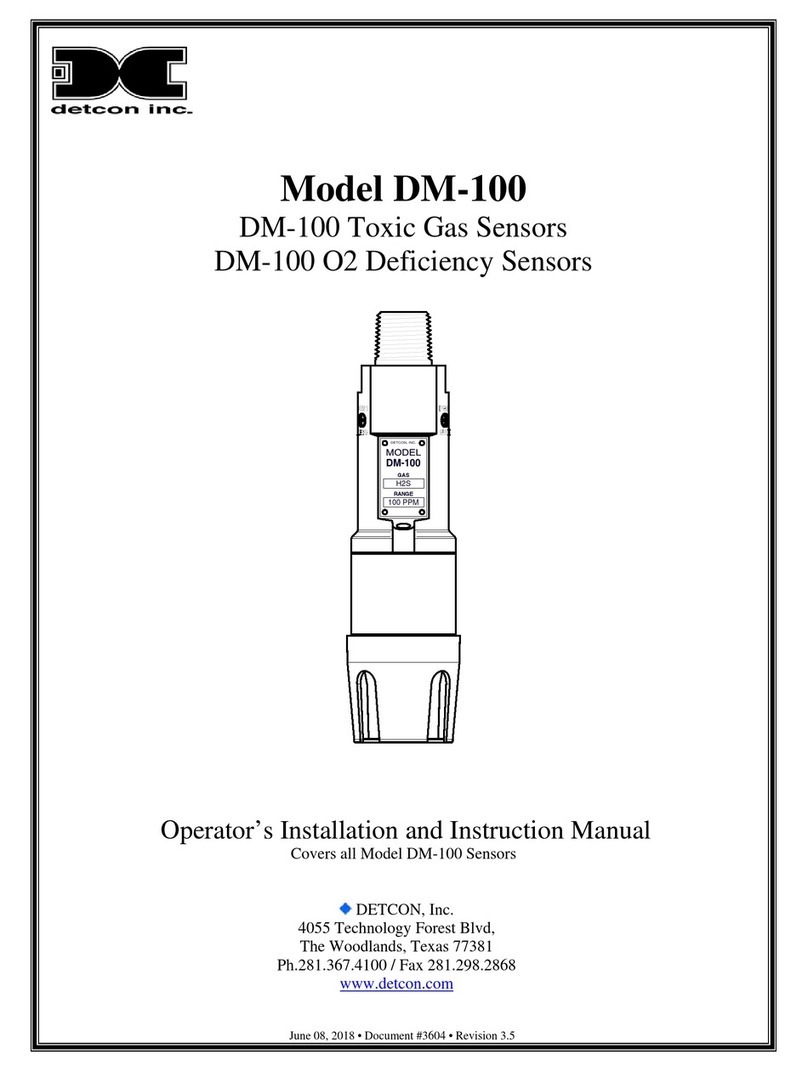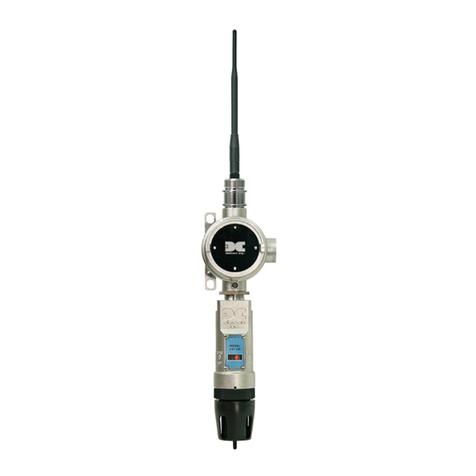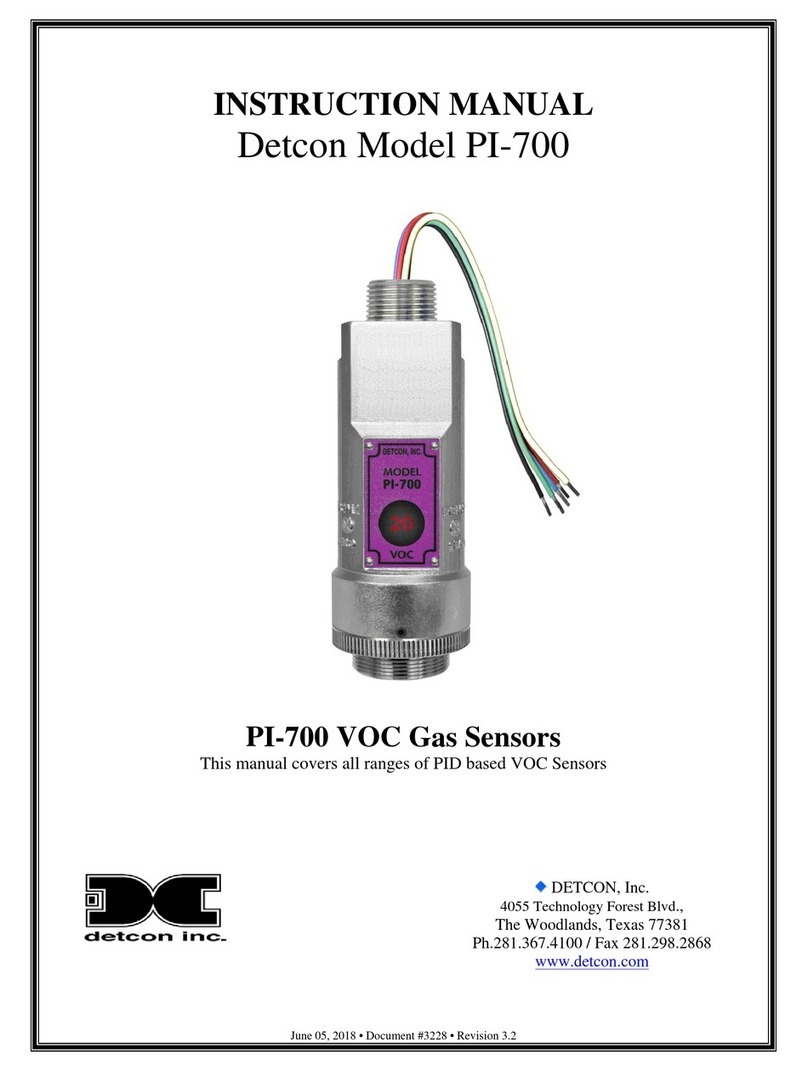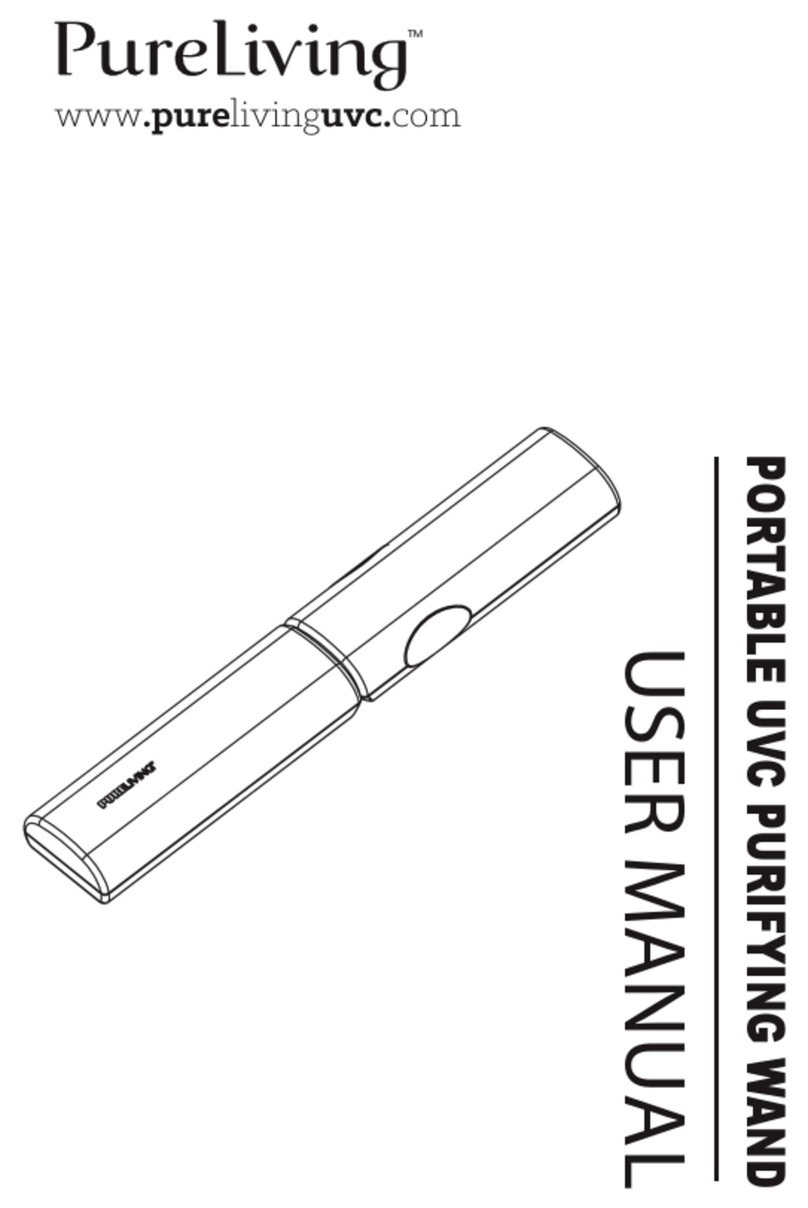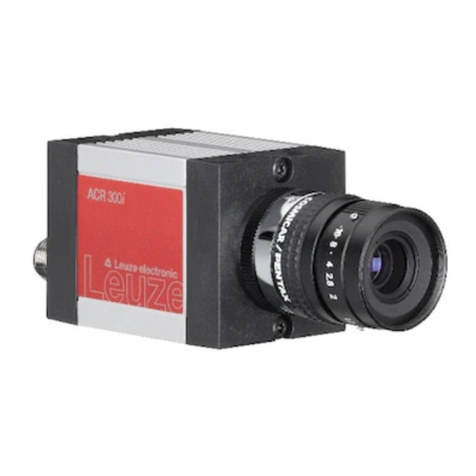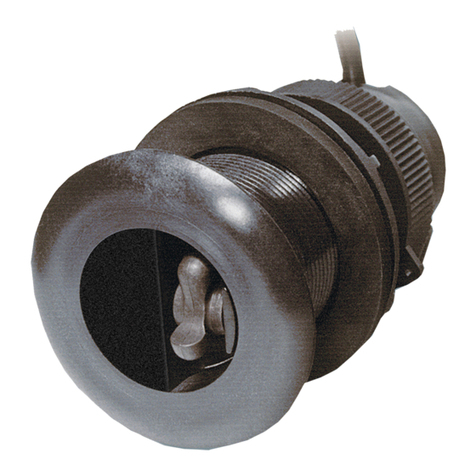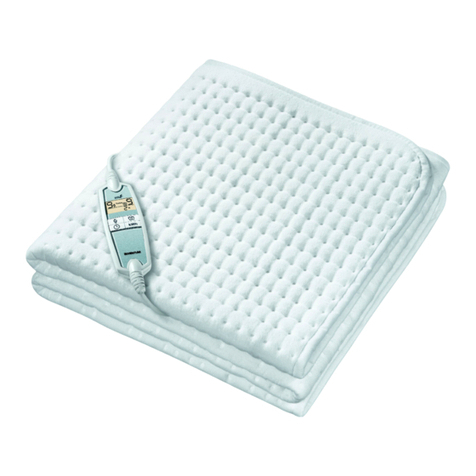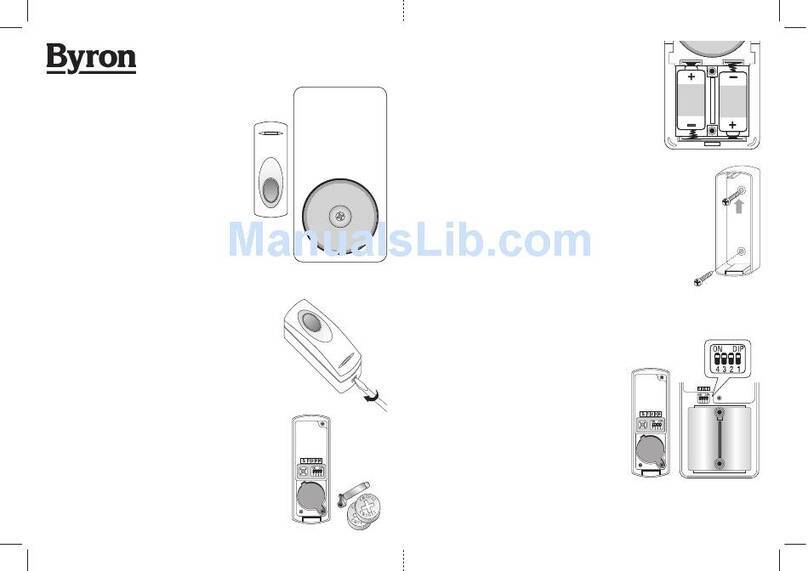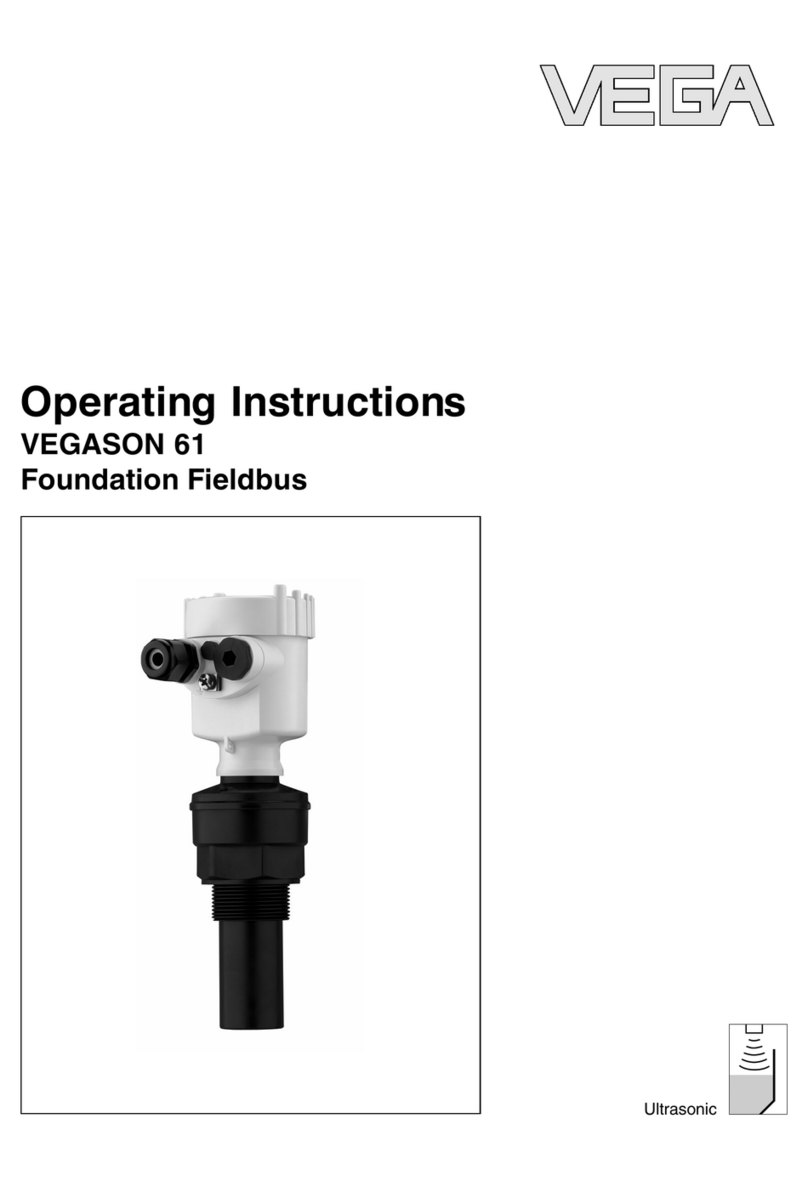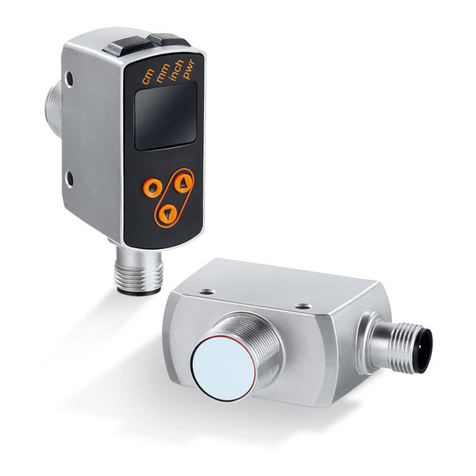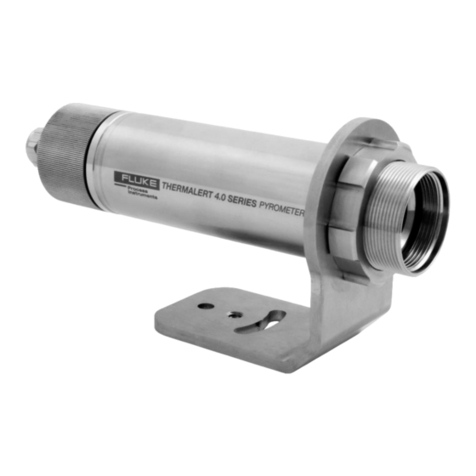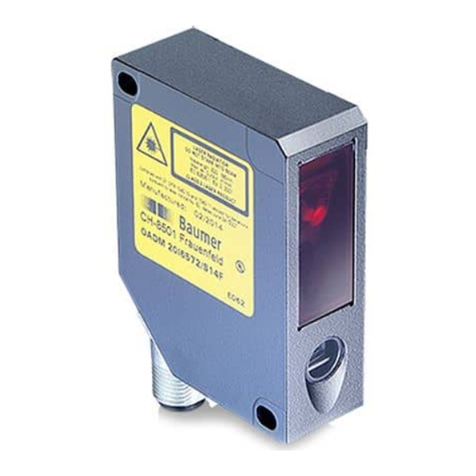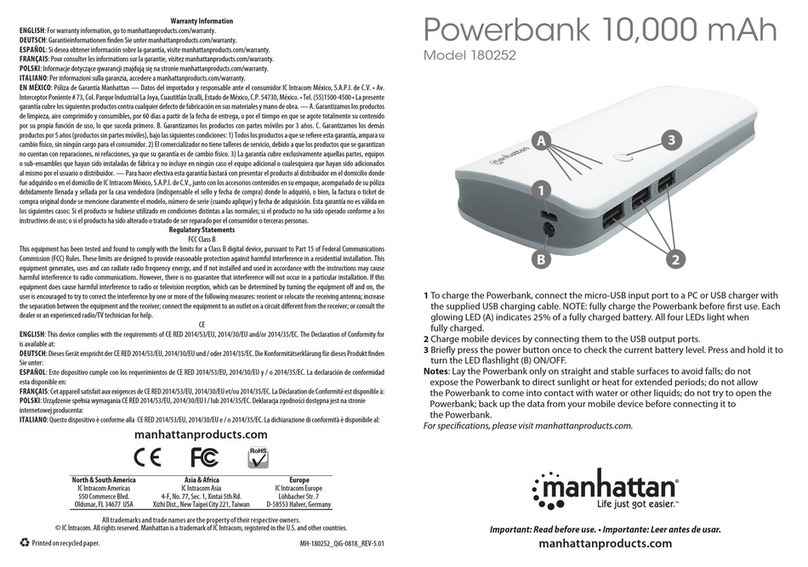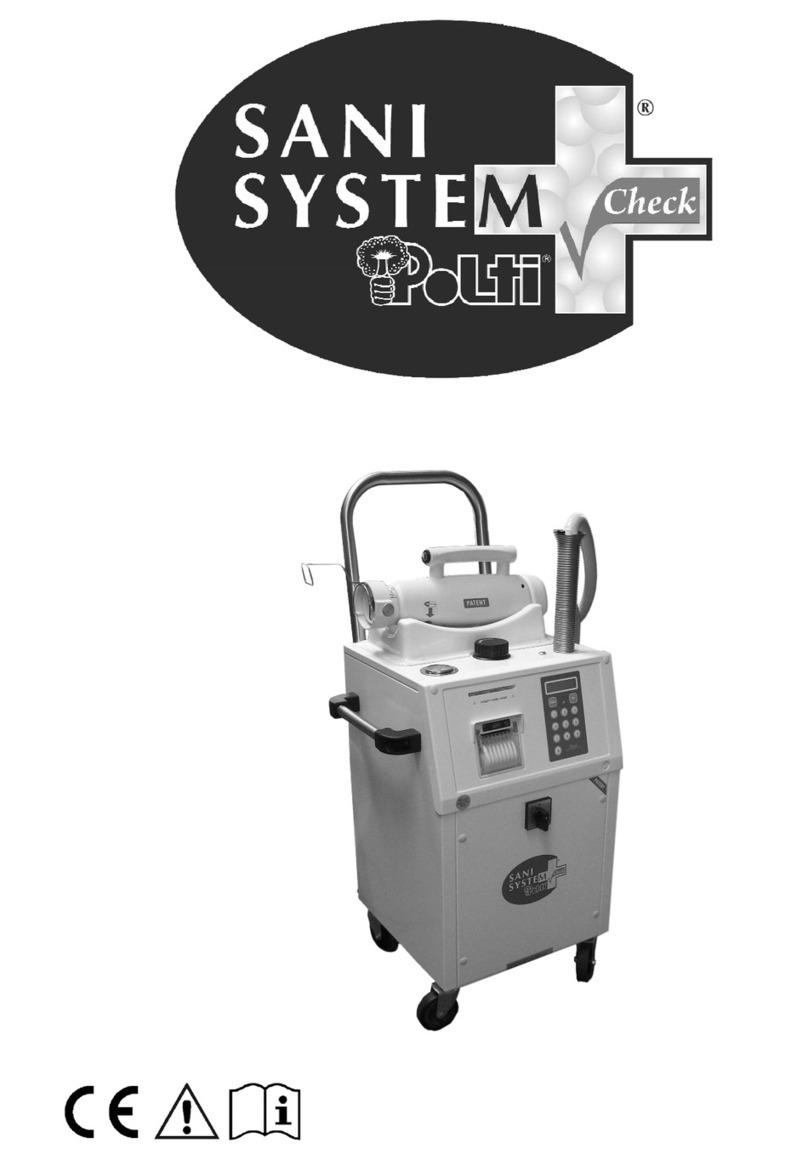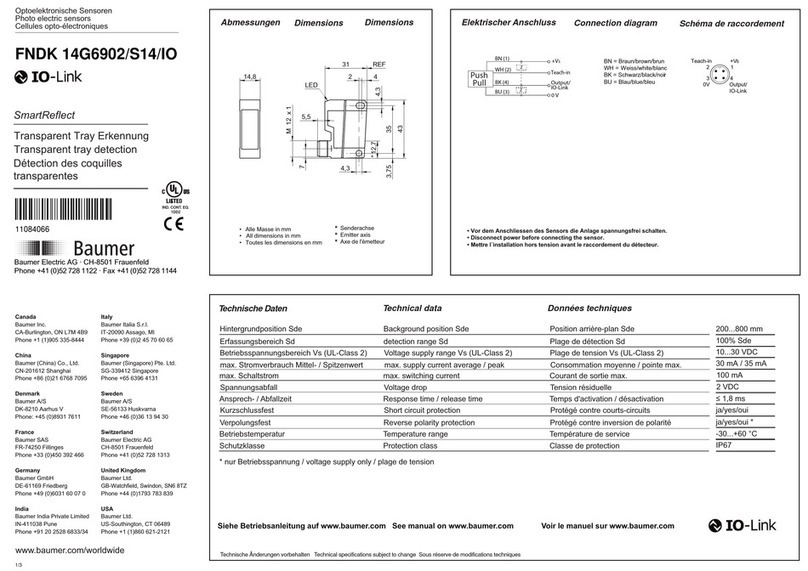Detcon SmartWireless CX User manual

Sentinel CX
Sentinel CX Sensor Station IM Rev. 1.5 iii
Table of Contents
1. Introduction............................................................................................................................................1
1.1 Features ..........................................................................................................................................................1
1.2 Optional Components.....................................................................................................................................2
1.3 Alarms and Fault Condition ...........................................................................................................................2
1.4 Power Supply-Internal Rechargeable Battery and Charging Accessory ........................................................3
1.5 Radio Module................................................................................................................................................. 4
1.6 Sensor Inputs..................................................................................................................................................5
1.7 Alarm Outputs................................................................................................................................................6
1.8 Power Switch..................................................................................................................................................8
1.9 Power Connector............................................................................................................................................8
1.10 Remote I/O Cabling Accessory and Safe Use................................................................................................8
2. Safety Guidelines for safe use.............................................................................................................10
3. Installation............................................................................................................................................12
3.1 Initial Setup .................................................................................................................................................. 12
4. Recharging the Internal Battery Pack...............................................................................................18
4.1 Non-Hazardous and Indoor Location........................................................................................................... 18
4.2 Connecting to Mains Supply........................................................................................................................ 18
5. Maintenance and Service Personnel Activities..................................................................................19
5.1 Replacement of Condensation Prevention Packet........................................................................................ 19
5.2 Replacement of Lithium Ion Battery Pack ................................................................................................... 19
5.3 Proper Cleaning Procedure........................................................................................................................... 19
5.4 Servicing Risks and Verification of Safe State after Servicing.................................................................... 20
6. Troubleshooting Guide........................................................................................................................21
7. Customer Support and Service Policy...............................................................................................22
8. Warranty Notice ..................................................................................................................................23
9. Appendix...............................................................................................................................................24
9.1 Specifications ............................................................................................................................................... 24
9.2 Spare Parts and Wireless Accessories .......................................................................................................... 25
9.3 Revision Log ................................................................................................................................................26
Table of Figures
Figure 1 SmartWireless® CX Sensor Station..................................................................................................1
Figure 2 SmartWireless® CXT Radio Module ...............................................................................................4
Figure 3 Sensor Input PCA..............................................................................................................................5
Figure 4 Sensor Input Connector Pin-out........................................................................................................6
Figure 5 Relay PCA.........................................................................................................................................6
Figure 6 External Alarm Connector pin out for ‘Wet’ alarm contacts ............................................................7
Figure 7 External Alarm Connector Pin out for ‘Dry’ alarm contacts.............................................................7
Figure 8 Power Connector...............................................................................................................................8
Figure 9 Mount CX on Tripod.......................................................................................................................13
Figure 10 Attach Sensor Brackets to Tripod .................................................................................................14
Figure 11 A1 C1D2 Alarm Connections .......................................................................................................14
Figure 12 Enclosure.......................................................................................................................................15
Figure 13 Connector to Transceiver ..............................................................................................................15
Figure 14 Battery Bracket in position............................................................................................................16
Figure 15 Battery and Battery Bracket..........................................................................................................16
Figure 16 Battery Connections......................................................................................................................17

Sentinel CX
Sentinel CX Sensor Station IM Rev. 1.5 Page 1 of 26
1. Introduction
1.1 Features
The SmartWireless® CX Sensor Station (Figure 1) is an accessory to the SmartWireless® CXT. The CX
wirelessly transmits the data from the sensors to the CXT and includes a battery that powers the radio,
alarm devices, and the attached sensors. The CX can sustain up to four 4-20mA wired sensors.
Remote mounted gas detection sensors include any analog 4-20maDC device such as;
toxic gas,
combustible gas, or
oxygen deficiency sensors.
Antenna
Strobe
Power
Switch
RXT-320
Transceiver
4-20 Sensor Input PCA
& 4 Relay PCA
Alarm Horn
Battery Pack
Sensor Ports
Optional
Ext Alarm
Connector
Power
Connector
Power
LED
Figure 1 SmartWireless® CX Sensor Station
The SmartWireless® CX Sensor Station package is a Division 2 assembly housed in a 316 stainless steel
enclosure that offers various connector options for multiple configurations.
System components of the SmartWireless® gas detection system include;
Smart Wireless CXT Controller
Smart Wireless CX Sensor Station,
alarm stations and
gas detection sensors.

Sentinel CX
Sentinel CX Sensor Station IM Rev. 1.5 Page 2 of 26
SmartWireless® CXT Controller
The Detcon SmartWireless® CXT controller is a multi-channel mobile gas detection control system
mounted on a tripod or a suitable stand. The CXT can be utilized as a self-contained gas detection,
display/alarm system package or wirelessly connected to the main network. The CXT is equipped with an
auto configure system to automatically search for Detcon equipment associated with the controller.
SmartWireless® CX Sensor Station
The SmartWireless® CX Sensor Station is an accessory to the SmartWireless® CXT. The CX wirelessly
transmits the data from up to 4 wired sensors back to the CXT and includes a battery that powers the radio,
alarm devices, and the attached sensors.
Alarm Stations
Alarm stations can be used as part of the gas detection system. Class I Division 1 and Class I Division 2
alarm stations are available. The stations are battery powered and controlled wirelessly by the CXT. The
strobe and horn installed on the CX are activated by the CXT when the alarms levels are reached.
Alarm options are as follows:
1. Integral audio visual mounted on the CX (Class 1; Division 2 only)
2. Standalone audio visual alarm station (Class 1; Division 2)
3. Standalone audio visual alarm station (Class 1; Division 1)
Gas Detection Sensors
Gas sensors with a 4-20mA output can be connected directly to the CX. The Model CX sensors from
Detcon are designed specifically to work with the SmartWireless® CX.
Associated Accessories
The accessories associated for the CX Controller product are as follows:
Detcon Tripod
Detcon Battery Charging Accessory
Detcon Division 2 cables (various)
Detcon Operators Manual
1.2 Optional Components
Options for the SmartWireless® CX Sensor Station are as follows:
strobe
horn
external ‘Wet’ or ‘Dry’ alarm port
1.3 Alarms and Fault Condition
The CX Sensor Station includes an optional strobe and/or a piezoelectric horn and an external alarm
connector. The strobe is associated with Alarm 1, the horn is associated with Alarm2 and the external alarm
connector utilizes all alarm outputs (alarm 1, 2, 3 and fault) for connection to external alarm devices. The
external alarm outputs can be used to control annunciating devices or as signal inputs to other control
devices. The CX permits alarm and fault conditions to cause an assigned relay to fire, triggering external
alarm devices. When the alarm level is reached either the devices mounted to the box or attached to the
external alarm connector are activated, or both. The assigned relay outputs will return to normal state when
a gas alarm or a fault condition clears. The Alarm Relay Output can be either ‘Wet’ or ‘Dry’ determined

Sentinel CX
Sentinel CX Sensor Station IM Rev. 1.5 Page 3 of 26
when the unit is ordered. The ‘Wet output connector provides 12V outputs for external alarms. The ‘Dry’
output connector provides dry contacts for external power to control external alarms.
All alarms can be configured as Energized/De-Energized, Latching/Non-Latching and Silenceable/Non-
Silenceable for the relays. This setup must be performed at the controller, refer to the controller manual for
more information.
1.4 Power Supply-Internal Rechargeable Battery and Charging
Accessory
SmartWireless® CX is powered by an internal rechargeable Smart Battery capable of delivering continuous
operation in a no alarm condition for two to eight weeks depending on the quantity and type of sensors tied
to the control panel. The internal re-chargeable battery pack shall only be charged in a non-hazardous area
where the required operating temperature limits are 0C to +45C. It may be used in the field and be
discharged in the temperature range of -20C to +60C.
CAUTION
The internal re-chargeable battery pack shall only be charged in a non-hazardous
area where the required operating temperature limits are 0C to +40C. Charging
outside this temperature range may degrade the life of the battery pack.
CAUTION
The Battery Pack Detcon PN 360-3S6PFP-290 contains an internal protection
circuit which maintains its safe operation against all potential hazard conditions.
CAUTION
No other Battery Pack except Detcon PN 360-3S6PFP-290 may be used in the
operation of this device.
The internal battery can only be recharged in a non-hazardous area and only using the Detcon supplied
Battery Charger Accessory that runs on AC power.
Detcon Approved Battery Charger Accessory Ratings:
AC Input Power
Voltage: 100-240 VAC, 50-60 Hz (requires correct PN version for optional 110 or 220 VAC use)
Current: 2.0 Amps maximum
DC Output Power
Voltage: 24+/- 1 VDC
Current: 3.1 Amps maximum
NOTE 1 No other Battery Charger or VDC input power source may be used with this CX Controller
product.

Sentinel CX
Sentinel CX Sensor Station IM Rev. 1.5 Page 4 of 26
1.5 Radio Module
The SmartWireless® CX offers a wireless option to connect it to the SmartWireless CXT and other devices
wirelessly. The Radio Module includes a transceiver that operates at 2.4GHz and conforms to non-licensed
radio frequency usage worldwide. Spread spectrum technology supports integrity and security for the
wireless network.
The SmartWireless CXT and CX products use a wireless network with a mesh topology. If radio
communication directly between two devices is impossible due to distance or obstruction, each wireless
device is capable of locating an alternate route through an additional wireless device to communicate with
the designated device. This innovative technology is designed to create a robust network that automatically
routes around congestion and line-of-sight obstacles while improving throughput as subscriber device
density increases.
The radio module is housed in a black ABS box mounted inside of the CX stainless steel enclosure. The
standard package includes two PCAs mounted inside the black ABS box (radio PCA and Smart battery
charging PCA), 5 dB antenna, and a protective antenna cover. The battery PCA includes circuitry to safely
recharge the battery from a 24VDC input and a fuel gauge circuit to monitor the charge remaining in the
battery.
The radio PCA includes a 2.4Ghz radio and a rotary switch for setting the RF channel of the system (Figure
2). Use a small screwdriver to rotate the switch until the arrow points to the desired RF channel number (16
channels available, 0h-Fh).
NOTE All devices within the network must be on the same RF channel to operate correctly.
Each radio module is required to have a unique address. These addresses typically start at 01h and continue
sequentially for each SmartWireless CX in the gas detection system. The radio PCA includes a pair of
rotary switches to set this address (Figure 2).
NOTE The switch for the most significant digit (MSD) is on the right and the least significant digit
(LSD) is on the left.
Figure 2 SmartWireless® CXT Radio Module
RF Channel
Selector Switch
Modbus
Address LSD
Switch
Modbus
Address MSD
Switch

Sentinel CX
Sentinel CX Sensor Station IM Rev. 1.5 Page 5 of 26
1.6 Sensor Inputs
The SmartWireless® CX Sensor Station includes a Sensor Input PCA that accepts 4-20mA inputs from up
to 4 attached sensors. The PCA includes two rotary switches to set its Modbus address (Figure 3). This
address is set to 01 for SmartWireless® systems using a CXT or Model X40 controller. If an MCX-32
controller is being used, this address needs to be unique for each CX Sensor Station in the system. For an
MCX-32 system, the addresses should start at 40h and continue sequentially for each CX in the system.
Sensor Connector Ratings
Voltage: 9-11.2 VDC
Current: 100 mA max through any single sensor connector
Modbus Address
LSD Switch
Modbus Address
MSD Switch
Figure 3 Sensor Input PCA
Four "quick connects" on the side of the CX are for sensor connection (Figure 4), supply power to the
sensor from the internal battery and accept the 4-20mA signal from the sensor.
NOTE Power supplied to the sensors is 11VDC. Any attached sensor must be designed to work at
this voltage level.
The four sensor input lines are fused at the PC board level for safety purposes. These fuses are not
designed for field replacement and shall not under any circumstances be attempted to be changed out by
anyone but Detcon Factory trained Service personnel.
CAUTION
These PC board mounted fuses are not designed for field replacement and shall not
under any circumstances be attempted to be changed out by anyone but Detcon
Factory-Trained Service personnel.

Sentinel CX
Sentinel CX Sensor Station IM Rev. 1.5 Page 6 of 26
Cable to Sensor 1
Cable 1
Blue
Brown
Grey
Green/Yellow
Sensor Connection
Power - (GND)
Power + (PWR)
Unit Ground
mA
Wire #4 4-20mA
Wire #2 PWR
Wire #1 GND
Wire #3 *Unit Ground
Sensor
1
4-20mA Wire #4
GND Wire #1
PWR Wire #2
Sensor Connector
*Unit Ground Wire #3
1
PCB
Enclosure
1
2
3
4
Cable 2
Black
White
Red
Green
Wire
1
2
3
4
Unit Ground is Chassis Ground
Figure 4 Sensor Input Connector Pin-out
1.7 Alarm Outputs
The SmartWireless® CX can optionally include an internal Relay PCA for activating alarm annunciators.
The Relay PCA includes four Class I Division 2 Groups A,B,C,D relays. If the SmartWireless® CX
includes an attached strobe and/or horn, these devices are also activated by the Relay PCA.
Each Relay PCA must have a unique Modbus address. The Relay PCA includes a single rotary switch to set
its Modbus address (Figure 5). The most significant digit of the address is hard-wired to “8”. The least
significant digit (LSD) is controlled by the rotary switch. The Relay PCA addresses should start at 80h and
continue sequentially for each SmartWireless® CX in the system.
Internal Alarm
Connections
Modbus™
Connections
Alarm Relay Connections
Modbus™
LSD Address
Figure 5 Relay PCA
If the SmartWireless® CX is ordered with the Relay PCA option, the Relay PCA can be configured to
provide either ‘Wet’ or ‘Dry’ contacts for external annunciator activation. The ‘Wet’ contact option
provides 11V Battery Power to external annunciators when an alarm is initiated. The ‘Wet’ relay contacts
are rated for 9-11.1 VDC, 2A max total (A1, A2, A3, and FLT outputs combined). The “wet” contacts are
available on a 5 pin Alarm Connector (Figure 6). These outputs are specifically meant for external 12V
annunciators such as the external A1 C1D2 Horn, which is designed to operate on the unit’s 12V Battery.

Sentinel CX
Sentinel CX Sensor Station IM Rev. 1.5 Page 7 of 26
12V Battery Power
12V Return
Relay PCA
NC
COM
NO
FAULT
NC
COM
NO
ALARM 3
NC
COM
NO
ALARM 2
NC
COM
NO
ALARM 1
Enclosure
ALARM 2 (Gray) 3
Alarm Connector
ALARM 3 (Brown) 4
FAULT (BLUE) 5
ALARM 1 (White) 2
GND (Black) 1
11
2
3
4
5
Figure 6 External Alarm Connector pin out for ‘Wet’ alarm contacts
Sensor Connector Ratings
Voltage: 9-11.2 VDC
Current: 2 Amps max through single relay connector (2 Amps max total across 4 connectors.
CAUTION
When utilizing ‘Wet’ contacts, the maximum power that can be drawn by the
annunciators is 2A.
The SmartWireless® CX is also available with ‘Dry’ relay contacts (Figure 7). Dry relay Contacts allow
the user to control annunciators that operate off an exterior power source that relies on the controller to
provide only contact closure to apply voltage to the annunciator. The relays are rated for 120-220 VAC/24
VDC, 2 A max. It is important to note that the ‘Dry’ contact feature utilizes a common return for all
annunciators.
Relay PCA
NC
COM
NO
FAULT
NC
COM
NO
ALARM 3
NC
COM
NO
ALARM 2
NC
COM
NO
ALARM 1
Enclosure
ALARM 2 (Green) 3
Alarm Connector
(Pin 2 is not used)
ALARM 3 (Orange) 4
FAULT (Blue) 6
ALARM 1 (White) 1
COM (Black) 5
11
2
3
4
5
6
Figure 7 External Alarm Connector Pin out for ‘Dry’ alarm contacts

Sentinel CX
Sentinel CX Sensor Station IM Rev. 1.5 Page 8 of 26
1.8 Power Switch
Power to the SmartWireless® CX is controlled by a power switch located on the bottom of the enclosure
(Figure 1). Pressing this switch while the power is off will turn the CX on. Pressing the switch while the
power is on will turn the power off. When the power to the CX is on, the green LED indicator on top of the
enclosure will be illuminated.
1.9 Power Connector
The internal battery inside the SmartWireless® CX Sensor Station can be recharged by connecting 24VDC
to the power connector on the side of the enclosure (Figure 1). A VAC/24VDC battery charging adapter is
included with every CX.
Detcon Approved Battery Charger Accessory Ratings:
AC Input Power
Voltage: 100-240 VAC, 50-60 Hz (requires correctly selected 110 VAC or 220 VAC Charger)
Current: 2.0 Amps maximum
DC Output Power
Voltage: 24+/- 1 VDC
Current: 3.1 Amps maximum
CAUTION
The SmartWireless® CX Sensor Station must be charged with the Detcon supplied
Battery Charger. (Detcon P/N: 976-0003BC-00T for 110VAC and P/N 976-
0003BC-220 for 220VAC ). Use of any other charger may damage the controller.
GND (Black) 2
+24VDC (White) 3
Chassis GND (Green) 1
Pin 1
Pin 2 Pin 3
Figure 8 Power Connector
1.10Remote I/O Cabling Accessory and Safe Use
The I/O cabling option designed for the CX Sensor Station and its safe use is described in the cabling
Speciation section in Section 9.1. A specific list of Detcon approved cabling option lengths are given in the
Spare Parts List.
Security clips, which require a tool for removal, are provided and are required for all I/O Turck connector
based cables. All Turck connectors should have the security clip engaged at all times except for when
disconnecting them in the safe area.

Sentinel CX
Sentinel CX Sensor Station IM Rev. 1.5 Page 9 of 26
CAUTION
Use only Detcon specified cable accessories described in this Manual to maintain
the Division 2 rating and safe use of this product.
CAUTION
Security clips, which require a tool for removal, are provided and are required for
all I/O Turck connector based cables. Turck connectors should have the security
clip engaged at all times except for when disconnecting in the safe area.

Sentinel CX
Sentinel CX Sensor Station IM Rev. 1.5 Page 10 of 26
2. Safety Guidelines for safe use
If equipment is used in a manner not specified by Detcon, the protection provided by the equipment may be
impaired. It is mandatory to read and follow all of the Safety Warnings and Cautions listed below.
Warning ThisapparatusissuitableforuseinClassI,Division2,GroupsA,B,C,D,orunclassifiedlocations.
Warning
Explosion Hazard. Do not make any disconnections while the circuit is live or
unless the area is known to be free of ignitable concentrations.
Warning
Charging of the internal Battery Pack shall never be done while equipment is
located in the Division 2 hazardous area. The equipment must be moved to a non-
hazardous are for the battery charging to take place. The temperature during the
indoor battery chargingshall be between 0 -40C.
Warning
Explosion Hazard. Do not remove or replace the Lithium Ion Battery Pack unless
power has been disconnected or unless the area is known to be free of ignitable
concentrations.
Warning Substitution of any component may impair suitability for Division 2 use.
Warning
Exposure to some chemicals may degrade the sealing properties of materials used
in the following devices used in this equipment; namely the Div2 Strobe, relay
contacts,andmagneticprogrammingswitches
Warning
All Turck connectors have dust/water sealing caps that are mandatory to be
installed on any connector that is not actively connected to a cable. This is
required to maintain the safety rating of this device. These caps are tethered
adjacent to each of the connector fittings for convenient connection.
CAUTION
The user must consult this manual for more information about any location marked
with this symbol.
DANGER
Danger of electrical shock. User must ensure that power has been disconnected
prior to installation or servicing of the equipment.

Sentinel CX
Sentinel CX Sensor Station IM Rev. 1.5 Page 11 of 26
Warning
When moving the base CX Sensor Station handle it with 2 hands securely around
the body of the unit so as to prevent a possible dropping or lifting hazard.
Warning
When wall mounting the CX Sensor Station, make sure to have 2 people working
together and follow the recommended wall mounting instruction in Section 3.1.9,
which requires suitable securement that holds four times the weight of the unit.
This will prevent chances of a dropping hazard during the installation or prevent
the risk of the unit falling off from the wall mount.
Warning
When moving or manipulating the CX Sensor Station mounted to the Tripod
Assembly, 2 people are required to work together to avoid possible lifting risk.
Do not place your fingers in the areas of the sliding tripod legs as there is risk of
hand injury. Personnel should wear safety gloves while moving and setting up the
tripod assembly.
Warning
To avoid accidental tip-over risk of injury, press and anchor the 3 pointed legs of
the tripod deep and firmly into the soft ground. If the ground is too hard for use
of the point, use an independent anchored pin and a short chain connecting to each
leg to secure the unit.
Warning
To avoid a tripping hazard, hang a brightly colored flag type marker half down
each tripod leg to provide visual warning of the location of the tripod legs.
Warning
To avoid any possible ergonomic risk in interfacing with the CX Sensor Station,
make sure it is installed at a height of 4-5 feet. Place the unit in place where it is
easy to access the front of the unit and as possible avoid placing it where there is
constant direct sunlight.

Sentinel CX
Sentinel CX Sensor Station IM Rev. 1.5 Page 12 of 26
3. Installation
3.1 Initial Setup
The Detcon tripod (P/N 975-TRIPOD-100) provides a stable and mobile base for the SmartWireless® CX
Sensor Station. A maximum of two sensors can be secured to the tripod using Detcon brackets (P/N 943-
004413-000) installed on the tripod.
1. Unpack the tripod, open the legs and place on a level surface. The tripod must have the 3 legs
extended to widest position possible and be locked in place. The tripod must be firmly located on
level terrain or this is an extreme safety risk of the unit tipping over and causing personnel harm or
equipment damage. As is possible, the points of the tripod legs should be equally plunged into the
ground to make the tripod most firmly stabilized.
CAUTION
The tripod must have the 3 legs extended to widest position possible and be locked
in place. It then shall be firmly located on level terrain or there is an extreme safety
risk of the unit tipping over and causing personnel harm and/or equipment damage.
2. Mount the CX Sensor Station to the center pipe using the supplied U-bolts in accordance with
Figure 9. The height position should be about 4-5 feet maximum to minimize tip-over potential.
The U-bolts should be thoroughly tightened such that there is no vertical slide of the controller up
or down the tripod center pipe. If it slides it may be a safety issue related to personnel injury.
CAUTION
The installed height position should be 4-5 feet maximum to minimize tip-over
potential. The U-bolts should be thoroughly tightened so there is no chance for
vertical slide of the controller up or down the tripod center pipe. If it slides
unexpectedly it is a safety issue related to personnel injury and/or tipping over.
NOTE Position the CX controller on the tripod and position the tripod such that all disconnecting
devices are readily accessible.
3. Install the 8" antenna on the antenna connector on the top right of the CX Sensor Station (Figure 1).
4. Secure the antenna cover over the antenna.
5. If sensors are being mounted on the tripod legs, attach the sensor mounting brackets to the tripod
legs using the supplied 1/4" bolts, nuts and lock washers in accordance with Figure 10.

Sentinel CX
Sentinel CX Sensor Station IM Rev. 1.5 Page 13 of 26
Pipe Mounting U-Bolts
and hardware
Tripod Center Pipe
12"
3.5" 4.5"
10.25"
11.25"
12.25"
21.3"
Figure 9 Mount CX on Tripod
Mounting Plate
Tripod Leg
Mounting
Hardware
Mounting
Support
Sensor with
Mini Condulet

Sentinel CX
Sentinel CX Sensor Station IM Rev. 1.5 Page 14 of 26
Figure 10 Attach Sensor Brackets to Tripod
6. Hang the sensors on the brackets using the hook and pin supplied with the bracket.
7. Connect sensor cables to the sensor ports on the CX (Figure 1).
8. If the unit is ordered with the optional external A1 C1D2 Horn, the horn should be mounted either
on the tripod, or on a separate tripod. . The optional A1 C1D2 Horn requires the cable for the
External ‘Wet’ Alarms.
a. The horn should be wired to the ‘Wet’ Alarm Output cable per Figure 11.
b. The alarm Cable should be connected to the External Alarm Connector on the controller.
Red
Black
Green/Yellow
Black
Gray
Turck Alarm Cable
from Sentinel
C1D1 Cable Assembly
12-24 Alarm
Terminal PCA
White
To
Horn
Figure 11 A1 C1D2 Alarm Connections
Battery Installation
9. Loosen the screws holding the door panel in place, and swing the front door of the enclosure open
to gain access to the battery bracket.

Sentinel CX
Sentinel CX Sensor Station IM Rev. 1.5 Page 15 of 26
Figure 12 Enclosure
10. Unplug the connector from the transceiver, and move it out of the way to gain access to the screws
holding the battery bracket in place. There should be enough of a service loop to safely move this
connector out of the way for removal/installation of the battery bracket.
Figure 13 Connector to Transceiver
11. Remove the 6-32 screws and washers holding the battery bracket is place, and remove the bracket
from the enclosure. Retain the screws and washers for installation of the bracket with the battery
pack.

Sentinel CX
Sentinel CX Sensor Station IM Rev. 1.5 Page 16 of 26
Figure 14 Battery Bracket in position
12. Install the battery pack in the bracket. The battery will fit snugly into the holder, being somewhat
held in place by the foam padding in the bracket.
Figure 15 Battery and Battery Bracket
13. Position the battery bracket (and battery) with the connector on the left side, and install the battery
and bracket in the enclosure using the 6-32 screws removed is step 11. Some wiring may need to
be moved out of the way during this process to ensure that the wiring is not caught under the
bracket.
14. Locate the connector mate for the battery connector, and plug the two connectors together.
Table of contents
Other Detcon Accessories manuals
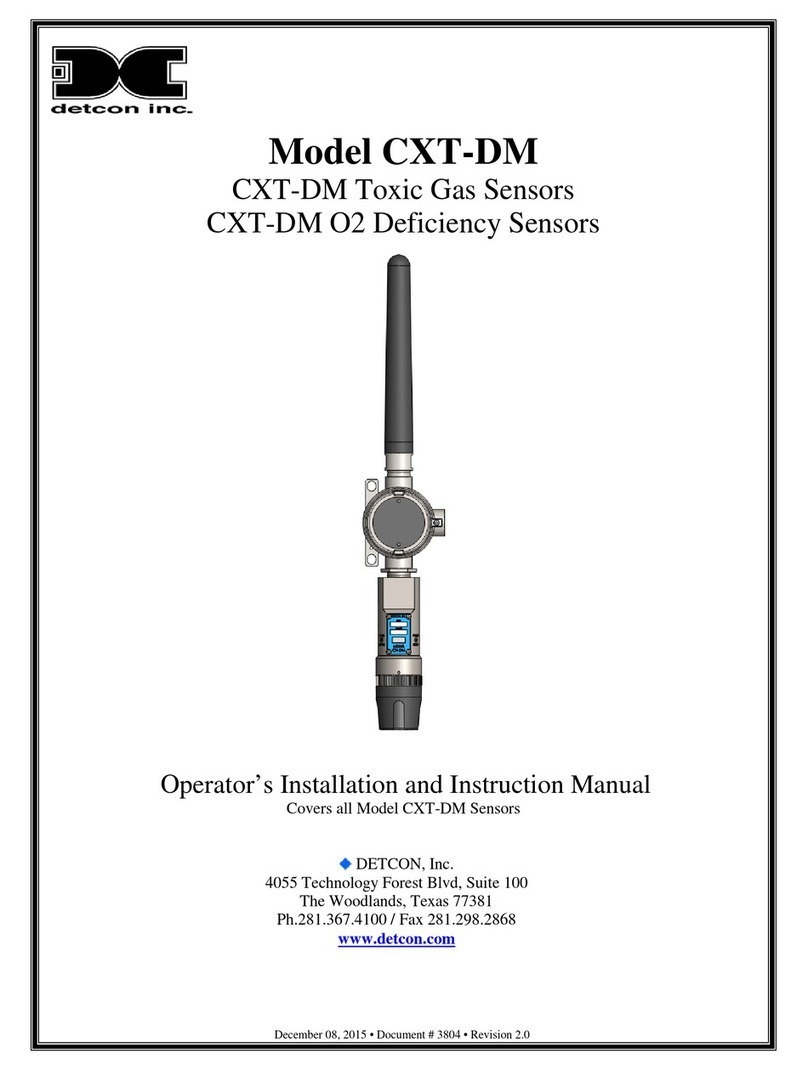
Detcon
Detcon CXT-DM User manual
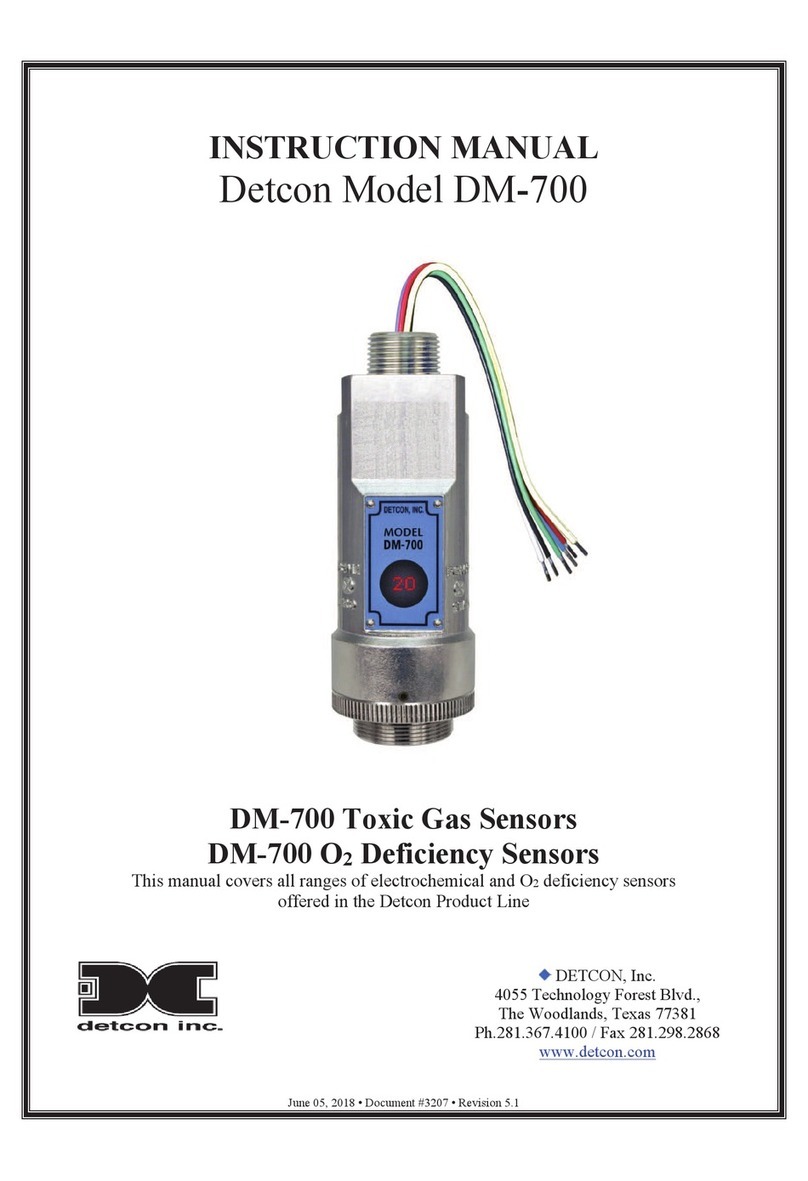
Detcon
Detcon DM-700 User manual
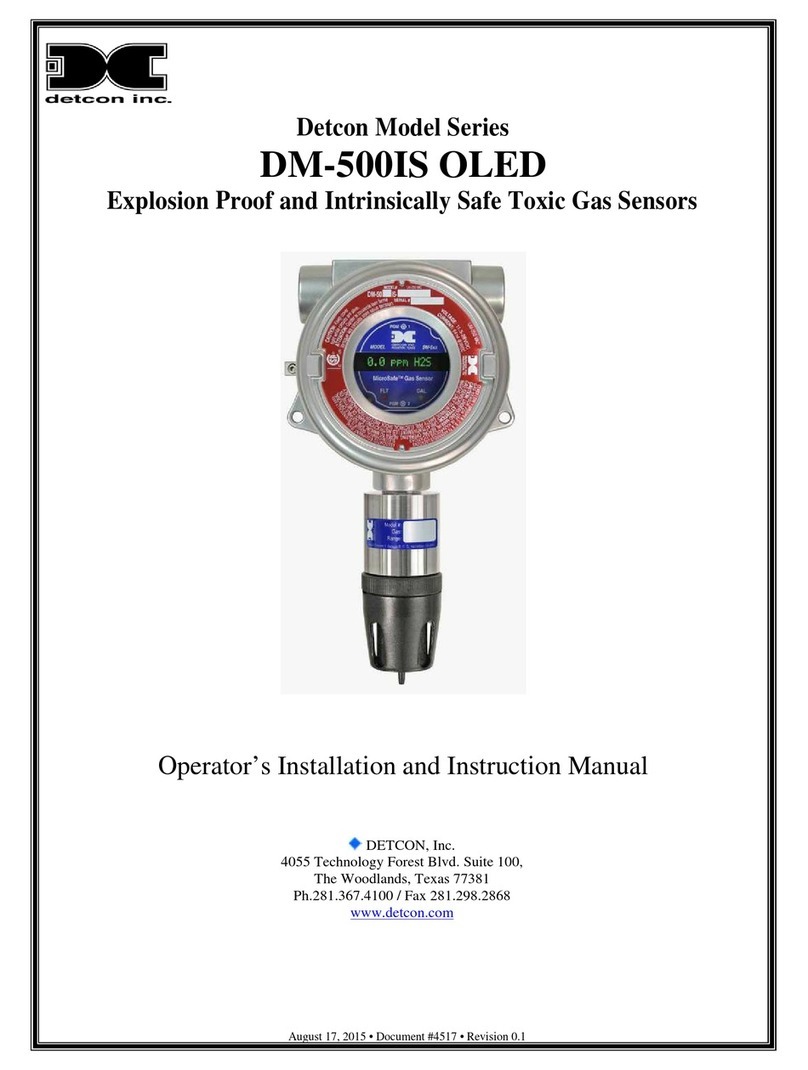
Detcon
Detcon DM-500IS OLED Series User manual
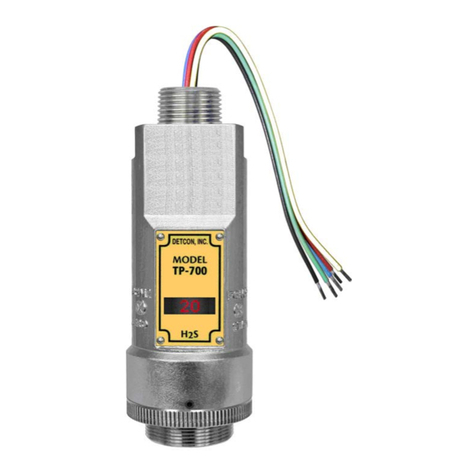
Detcon
Detcon TP-700 User manual
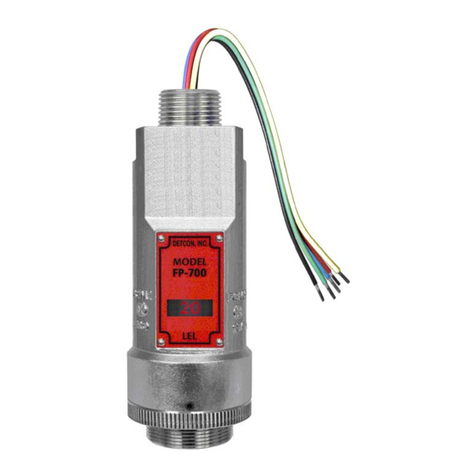
Detcon
Detcon FP-700 User manual
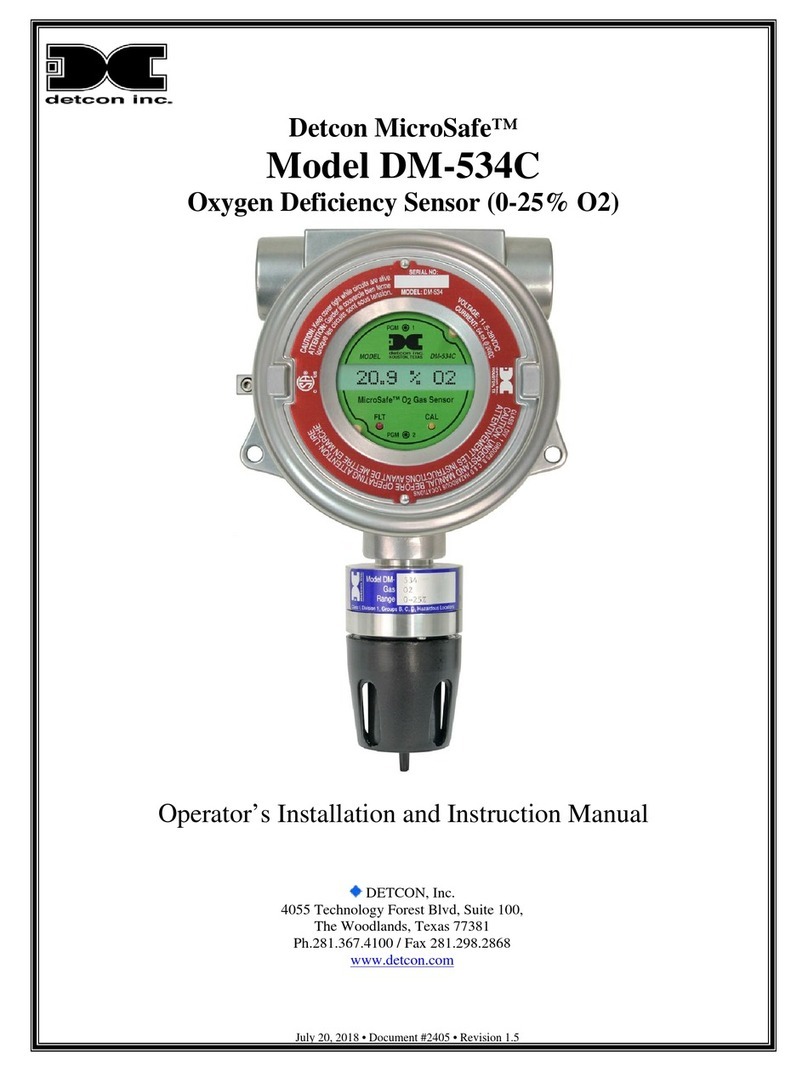
Detcon
Detcon MicroSafe DM-534C User manual
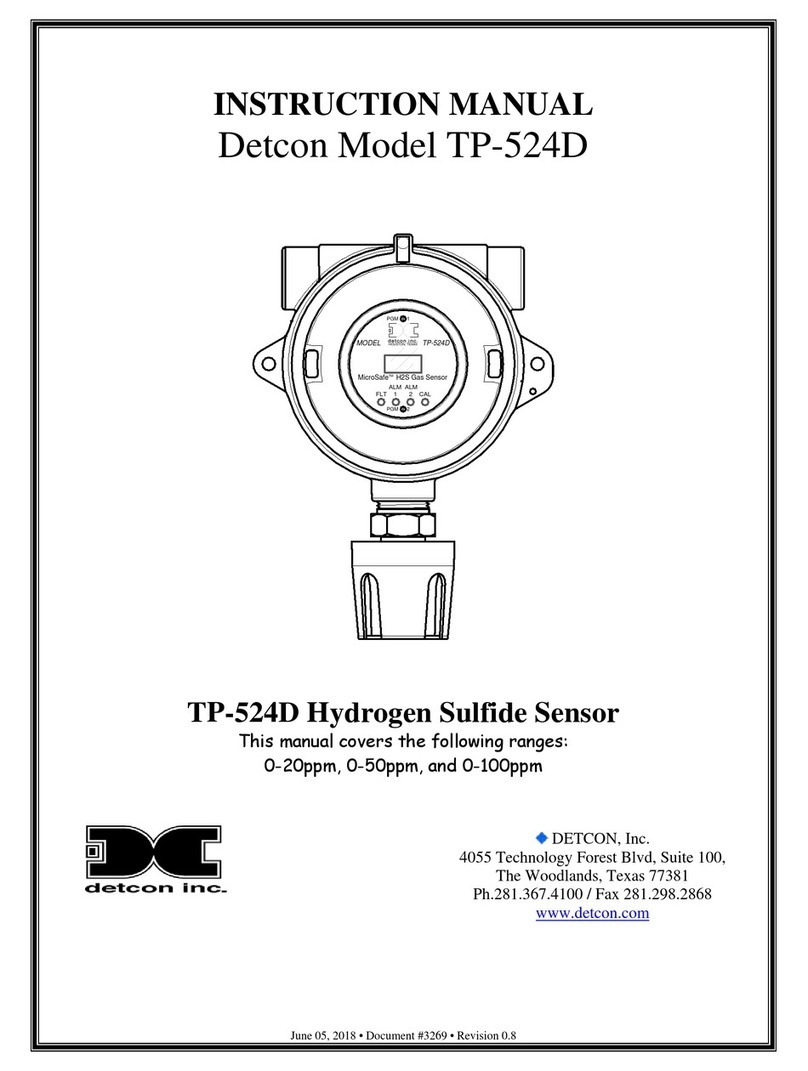
Detcon
Detcon TP-524D User manual
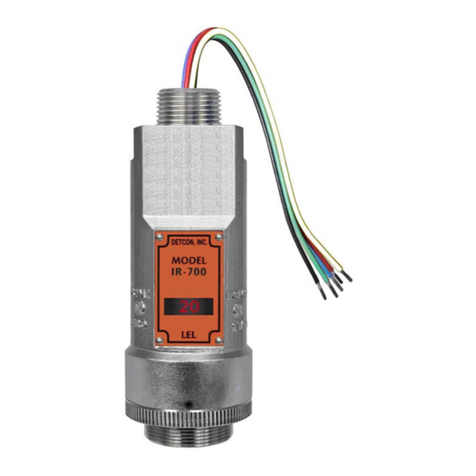
Detcon
Detcon IR-700 User manual
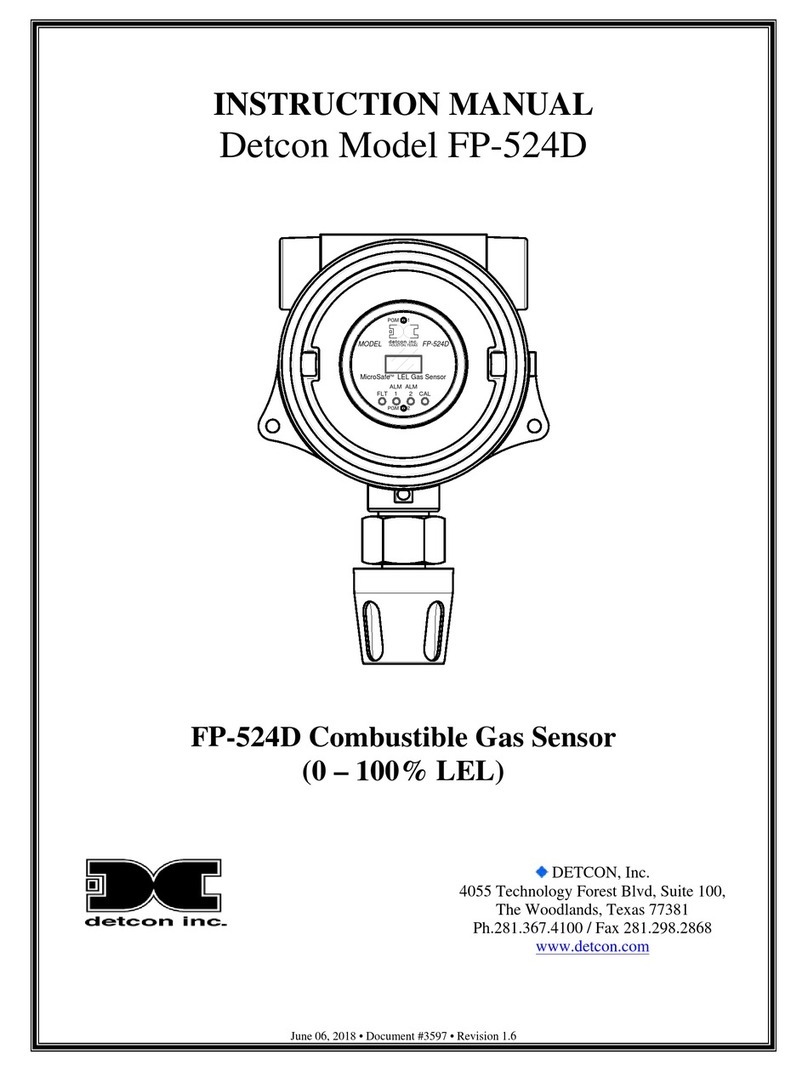
Detcon
Detcon FP-524D User manual
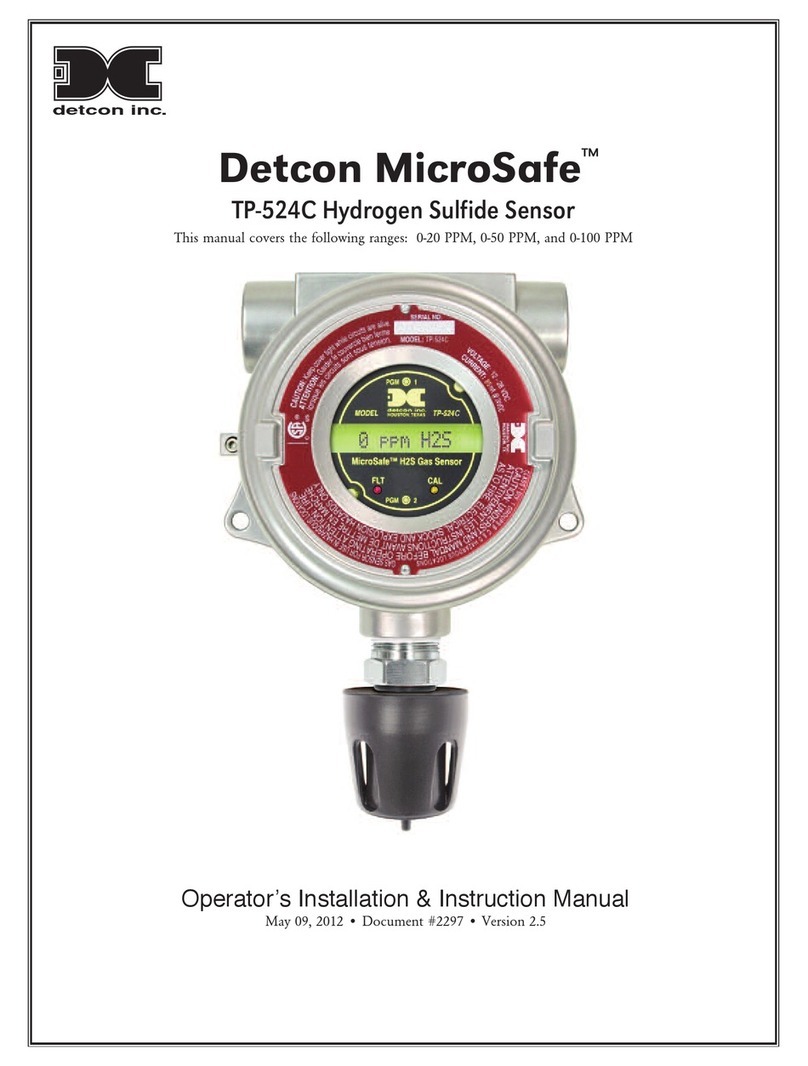
Detcon
Detcon MicroSafe TP-524C User manual



